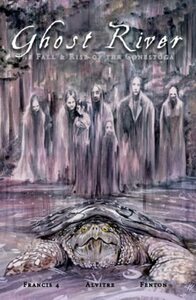Take a photo of a barcode or cover
Before I get into my criticism of the book, because I have a few, I would like to say first and foremost that it must have been an incredibly difficult book to write. It's not a topic to be taken lightly, and yet the authors wanted to make it accessible for everybody so that people could learn about the history of native American people and the wrongs that had been done to them.
That said, I feel like it could have been so much more.
I understand the authors' choice of creating a graphic novel. Pictures to accompany (fewer) words make the story easier to digest and understand. But... should it really be easy to take in? I think that if it had been written as a novel in first-person or close third-person, it would have hit so much harder because the reader gets to spend more time with the characters and could get to know them better. It's always so much more gut-wrenching when a person that has been fleshed out, become almost real, is hurt in a way that can't be healed. The graphic novel, by using an omniscient third-person narrator and having slightly jarring POV changes, mitigates the intensity of the reader's connection to the characters. I think the graphic novel itself could in fact a storyboard for a written novel—that would work really well. But Ghost River had so much potential that I'm a little bit disappointed by it.
All that said, it is still a gorgeous graphic novel. I wasn't the biggest fan of the art style, but it had the right feeling to it for a story like this. I would encourage reading it because I had no idea about the Conestoga massacre, and I feel like it's an important part of history that can't be glossed over.
That said, I feel like it could have been so much more.
I understand the authors' choice of creating a graphic novel. Pictures to accompany (fewer) words make the story easier to digest and understand. But... should it really be easy to take in? I think that if it had been written as a novel in first-person or close third-person, it would have hit so much harder because the reader gets to spend more time with the characters and could get to know them better. It's always so much more gut-wrenching when a person that has been fleshed out, become almost real, is hurt in a way that can't be healed. The graphic novel, by using an omniscient third-person narrator and having slightly jarring POV changes, mitigates the intensity of the reader's connection to the characters. I think the graphic novel itself could in fact a storyboard for a written novel—that would work really well. But Ghost River had so much potential that I'm a little bit disappointed by it.
All that said, it is still a gorgeous graphic novel. I wasn't the biggest fan of the art style, but it had the right feeling to it for a story like this. I would encourage reading it because I had no idea about the Conestoga massacre, and I feel like it's an important part of history that can't be glossed over.
The online edition at https://read.ghostriver.org/ is particularly powerful due to the tags that lead the reader to original sources, explanations of artists, and voices of those gathered to remember.
While I appreciate the importance of this story and Alvitre's beautifully textured artwork, I wish the authors felt more artistic freedom to dig into the lives of the Conestoga and give me more investment and more concrete details about the massacre. The supplemental materials were more enlightening than the comic story.
challenging
dark
emotional
hopeful
informative
mysterious
reflective
sad
tense
fast-paced
Graphic: Death, Gun violence, Racism, Grief, Murder, Colonisation
Moderate: Blood
Amazing, heartbreaking history. The website includes a lot of great background information, as well. https://read.ghostriver.org/
challenging
dark
hopeful
informative
sad
tense
medium-paced
Ghost River: The Fall and Rise of the Conestoga is not only a graphic novel, but the result of an exhaustive and collaborative research project undertaken to highlight the perspective and humanity of the Conestoga people with the help of an impressive number of archives, libraries, historians and Indigenous storytellers and community members. The narrative of the Conestoga massacre is told through the eyes of the Conestoga themselves, through the remembrance of their ancestors who remain with us today, and through the experiences of the book's creators as they researched and assessed how this story needed to be told.
Portraying the creators of this graphic novel like characters within it was a wise decision that provides readers with a greater understanding their efforts, both in terms of accuracy and artistry. The full book also includes a variety of supplemental materials, such as introductions and script notes, for this purpose. Francis IV mentions in his script annotations how the time-skips throughout the book are purposefully done to contrast with Western linear narrative structure, as Native stories are often instead "cyclical and contextual". This alternate structure not only frames this historical retelling through a Native understanding, but heightens the emotion of Francis IV and Alvitre's work. Similarly, Alvitre mentions in her introduction how her choice of artistic tools was done to deliberately mimic the style of the political cartoons stemming from the massacre, while instead "reclaim[ing] that period with fresh representational art of the Native Americans who lived and died during this period of history". Her choice of earth tone pigments intends to tie her artwork to the land the Conestoga would have felt intrinsically connected to, and creates a deep and resounding tone for the book, at least in my opinion.
This work is a shining example of how graphic novels can be utilized as a medium for accurate and empathetic historical retellings, while also transcending the medium itself. Half the book is actually made up of notes from the creators and researchers, alongside scans of primary sources they worked from and lesson plans educators can use through a series of classes. If you would like to learn even more, recommendations for further reading are also included alongside links to digital archives of the materials used for research. I feel very privileged to exist in a time in history where I was able to read and absorb this book and appreciate the resilience of the Conestoga hundreds of years after their story was wrongfully believed to have ended. Seeing the amount of work, and the methods, of researching accurate and fair records for the book was also very rewarding for me, since the value of libraries and archives are something I'm working towards being a part of myself. I highly recommend this graphic novel to other readers, but please mind the content warnings below.
Portraying the creators of this graphic novel like characters within it was a wise decision that provides readers with a greater understanding their efforts, both in terms of accuracy and artistry. The full book also includes a variety of supplemental materials, such as introductions and script notes, for this purpose. Francis IV mentions in his script annotations how the time-skips throughout the book are purposefully done to contrast with Western linear narrative structure, as Native stories are often instead "cyclical and contextual". This alternate structure not only frames this historical retelling through a Native understanding, but heightens the emotion of Francis IV and Alvitre's work. Similarly, Alvitre mentions in her introduction how her choice of artistic tools was done to deliberately mimic the style of the political cartoons stemming from the massacre, while instead "reclaim[ing] that period with fresh representational art of the Native Americans who lived and died during this period of history". Her choice of earth tone pigments intends to tie her artwork to the land the Conestoga would have felt intrinsically connected to, and creates a deep and resounding tone for the book, at least in my opinion.
This work is a shining example of how graphic novels can be utilized as a medium for accurate and empathetic historical retellings, while also transcending the medium itself. Half the book is actually made up of notes from the creators and researchers, alongside scans of primary sources they worked from and lesson plans educators can use through a series of classes. If you would like to learn even more, recommendations for further reading are also included alongside links to digital archives of the materials used for research. I feel very privileged to exist in a time in history where I was able to read and absorb this book and appreciate the resilience of the Conestoga hundreds of years after their story was wrongfully believed to have ended. Seeing the amount of work, and the methods, of researching accurate and fair records for the book was also very rewarding for me, since the value of libraries and archives are something I'm working towards being a part of myself. I highly recommend this graphic novel to other readers, but please mind the content warnings below.
Graphic: Child death, Confinement, Death, Hate crime, Racism, Violence, Blood, Grief, Murder, Colonisation
I loved that this story has been told through beautiful imagery and with information on the history of the Conestoga Massacre. This will resonate with you and leave you feeling sad that so much was lost and simultaneously hopeful for the unity of humankind. Read this for free at https://read.ghostriver.org/
This book is a beautifully drawn telling from the Indigenous perspective of the massacre of the Conestoga in Lancaster, PA.
It's free to read online here: https://read.ghostriver.org/
The book is more than that, though. It also contains historical documents linked throughout, plus interviews with the author, editor, artist, and local Native leaders. This is important revisionist history, and I recommend everyone, but especially Pennsylvanians, read this book to learn the truth about a chapter that is glossed over.
It's free to read online here: https://read.ghostriver.org/
The book is more than that, though. It also contains historical documents linked throughout, plus interviews with the author, editor, artist, and local Native leaders. This is important revisionist history, and I recommend everyone, but especially Pennsylvanians, read this book to learn the truth about a chapter that is glossed over.


